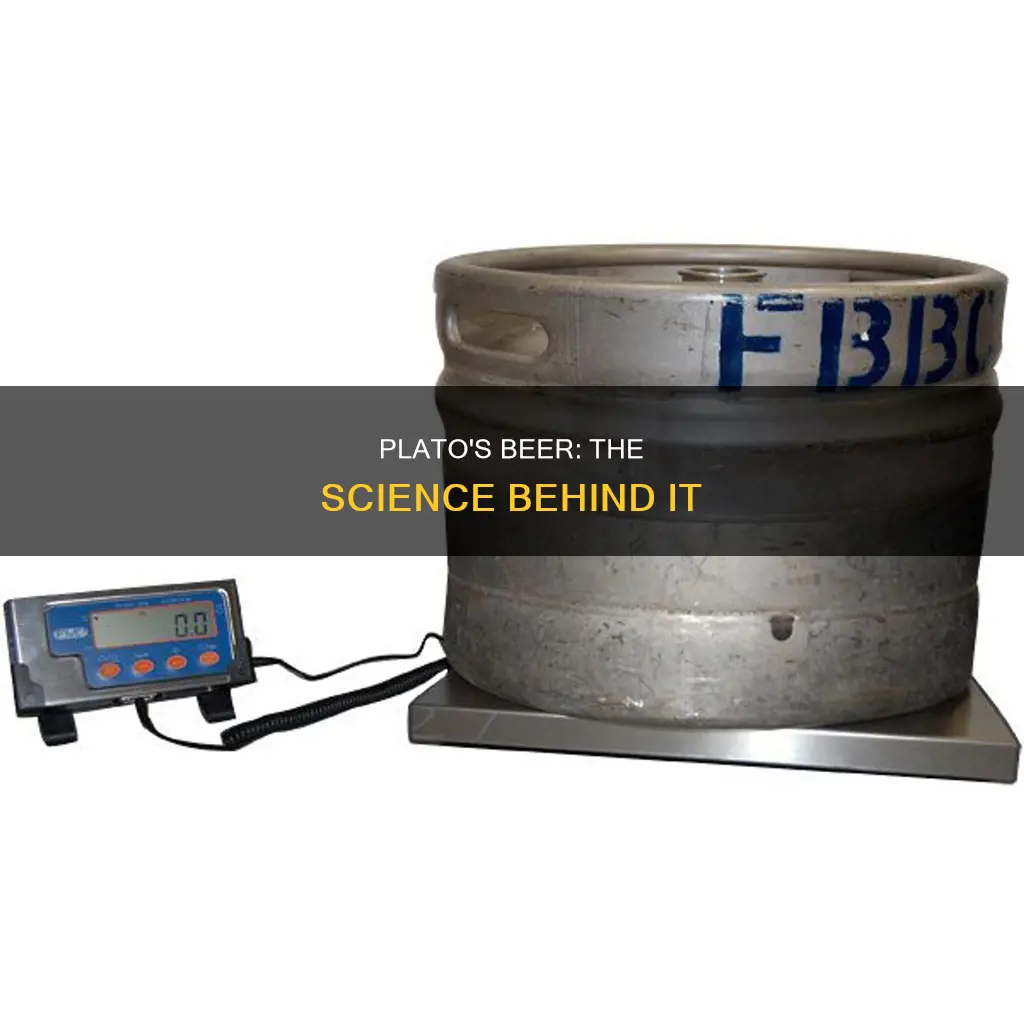
Plato, or Degrees Plato, is a measurement of the density of a beer solution as a percentage of sucrose by weight. It is used to indicate the ratio of fermentable sugars to water in the beer. Degrees Plato is based on specific gravity, which is the density of a liquid relative to the density of pure water. Brewers use a Plato hydrometer to determine the original extract of wort, which is the amount of material extracted from the mash. This is then used to calculate the alcohol content of the beer.
What You'll Learn

Plato scale measures density
The Plato scale, also known as the Plato gravity scale, is a measurement of the density of a solution, expressed as a percentage of sucrose by weight. In other words, it measures the density of a solution as if it were a sucrose solution with the same density. For example, a beer at 12°Plato has the same density as a water-sucrose solution containing 12% sucrose by weight. The Plato scale is important in brewing because it provides a very specific account of fermentable material in wort, which is crucial for determining the alcohol content of the final product.
The scale was originally developed in 1843 by Bohemian scientists Karl Balling and Simon Ack as "degrees Balling". It was later improved upon by Adolf Brix as "degrees Brix", and finally refined by Fritz Plato as "degrees Plato". The main difference between the Plato scale and other similar scales, such as the Balling and Brix scales, is the temperature at which the specific gravity measurement is taken. For the Plato scale, this temperature is 20°C, while for the Balling scale it is 17.5°C.
Brewers typically use either a calibrated refractometer or a hydrometer to measure degrees Plato. A hydrometer is a weighted instrument that floats in a liquid, and the depth to which it sinks is a measure of the liquid's density. The specific gravity of a liquid can be calculated by dividing the weight of a given volume of the liquid at a given temperature by the weight of the same volume of water at the same temperature.
The density of a wort, which is the unfermented beer, is largely dependent on its sugar content. During fermentation, yeast converts sugars into carbon dioxide and alcohol, which affects the density of the final beer product. By monitoring the decline in specific gravity over time, brewers can determine when fermentation is complete. This is known as the final gravity (FG). The difference between the original gravity (OG) and the FG gives an indication of how much sugar has been converted into alcohol, which in turn affects the strength of the beer.
Do Beer Cozies Work? The Science Behind It
You may want to see also

Indicates ratio of sugars to water
The Plato scale, also known as the Plato gravity scale, is a measurement of the concentration of dissolved solids in a brewery wort. Degrees Plato (°P) is used to quantify the concentration of extract (mainly sugars derived from malt, but also including other soluble material in wort) as a percentage by weight.
For example, a 10°P wort will contain 10 grams of extract per 100 grams of wort. The measurement of wort gravity is important to brewers as it indicates the potential alcoholic strength of the beer. As a rough guide, every 1°P generates approximately 0.4% alcohol by volume. A 12°P wort will produce an average of approximately 5% alcohol by volume, depending on the extent to which sugars are fermented out.
The Plato scale differs slightly from the Balling scale in that the measurement of specific gravity used to determine the dissolved solids content is carried out at 20°C for the Plato scale and 17.5°C for the Balling scale. Brewers measure the degrees Plato using either a calibrated refractometer or a hydrometer.
The Plato scale is used by most brewers worldwide, although brewers in the UK and those using British brewing traditions prefer to use the specific gravity scale instead. This is derived by measuring the specific gravity of the wort (where water is 1.000), multiplying by 1,000, and then subtracting 1,000 from that figure to give the degrees of gravity. Thus, a wort with a specific gravity of 1.048 is said to have 48 degrees of gravity. The Plato and gravity scales can be approximated by multiplying the °P by 4 to give the degrees of gravity. A 12°P wort is therefore approximately 48 degrees of gravity.
The professional brewing world refers to this collection of compounds as "extract". There is a strong and predictable relationship between the extract content of wort and its specific gravity. Because of this relationship, brewers can use hydrometers to measure wort extract content.
The Michigan Beer Chair: Engineering a Relaxing Experience
You may want to see also

Helps determine alcohol content
Plato (or °P) is a measurement system used in the brewing industry to determine the concentration of extract (sugars) in wort or beer. It was developed by German chemist Fritz Plato in the 19th century and is based on the specific gravity of the liquid being measured.
Plato measurements are used to determine the potential alcohol content of the beer, as well as the amount of residual sugar in the finished beer. The higher the Plato measurement, the higher the potential alcohol content and the sweeter the finished beer. For example, a beer with a wort Plato range of 6°-8° will have a lower alcohol content, usually around 2%, whereas a high Plato beer with a wort Plato range of 12°-20° will have an alcohol content of around 5%.
To calculate the alcohol by volume (ABV) in beer, brewers use a formula that takes into account the original gravity and final gravity of the beer. By comparing these two measurements, brewers can determine the alcohol content of their beer accurately. The formula for calculating ABV is:
ABV = 131.25(OG-FG)
Where OG is the original gravity, or the specific gravity before fermentation, and FG is the final gravity or specific gravity after fermentation.
Another way to calculate ABV is by measuring the amount of sugars or "extract" in the wort before and after fermentation and using an empirical formula to estimate the alcohol content. This method is based on the understanding that 1 gram of fermentable sugar will yield 0.51 gram of ethanol and 0.49 gram of carbon dioxide.
Plato measurements are more accurate than specific gravity readings when it comes to determining the sugar content of the wort and, consequently, the potential alcohol content of the beer. This is because Plato measurements are focused solely on the sugar content of the wort, whereas specific gravity readings are affected by all the components in the wort, including proteins and minerals.
Asking for Beer Outside Gas Stations: Does It Work?
You may want to see also

Brewers use calibrated refractometer or hydrometer
The Plato scale is used by brewers to measure the density of a solution as the percentage of sucrose by weight. It is a measurement of the concentration of dissolved solids in a brewery wort. Degrees Plato (°P) is used to quantify the concentration of extract (mainly sugars derived from malt, but also including other soluble material in wort) as a percentage by weight. For example, a 10°P wort will contain 10 g of extract per 100 g of wort. Brewers use a calibrated refractometer or a hydrometer to measure the degrees Plato.
A refractometer measures the "bending" of light as it passes through a material, a phenomenon known as refraction. Its measurement is called a refractive index. The refractive index for a solution of a known substance can be used to calculate the concentration of that solution. For example, winemakers use a refractometer to determine the amount of sugar in grape juice. To calibrate a refractometer, a calibration liquid is selected, which may be a special liquid or distilled water. The daylight plate is lifted, and a few drops of the liquid are placed on the prism assembly. The plate is closed, and the liquid is allowed to spread across the prism without any dry spots. After 30 seconds, the refractometer is pointed toward a natural light source, as artificial lighting can cause an inaccurate reading. The eyepiece is adjusted so that the scale is in focus, and the calibration screw is adjusted so that the refractometer reads exactly zero. The daylight plate and prism assembly are then cleaned with a soft, damp cloth, and a few drops of the test solution are placed on the prism assembly to take a reading.
A hydrometer is an instrument used for measuring the density or relative density of liquids based on the concept of buoyancy. It usually consists of a sealed hollow glass tube with a wider bottom portion for buoyancy, a ballast such as lead or mercury for stability, and a narrow stem with graduations for measuring. The liquid to be tested is poured into a tall container, and the hydrometer is gently lowered into the liquid until it floats freely. The point at which the surface of the liquid touches the stem of the hydrometer correlates to the relative density. Hydrometers are calibrated for different uses, such as measuring the density of milk, sugar in a liquid, or higher levels of alcohol in spirits. The hydrometer makes use of Archimedes' principle: a solid suspended in a fluid is buoyed by a force equal to the weight of the fluid displaced by the submerged part of the suspended solid. The lower the density of the fluid, the deeper a hydrometer of a given weight sinks; the stem is calibrated to give a numerical reading.
Understanding Beer Extracts: The Science Behind the Brew
You may want to see also

Plato values help calculate nutritional info
The Plato scale, also known as degrees Plato (°P), is a measurement of the concentration of dissolved solids in a brewery wort. It quantifies the concentration of extract (mainly sugars derived from malt and other soluble materials in wort) as a percentage by weight. For example, a 10°P wort will contain 10g of extract per 100g of wort.
The Plato scale is important as it indicates the potential alcoholic strength of the beer. Brewers can use it to determine the amount of yeast needed and the timetable of fermentation. Every 1°P generates approximately 0.4% alcohol by volume. So, a 12°P wort will produce an average of approximately 5% alcohol by volume, depending on the extent to which sugars are fermented out.
The specific gravity of the wort (where water is 1.000) is used to determine the degrees Plato. The specific gravity is multiplied by 1,000, and then 1,000 is subtracted from that figure to give the degrees Plato. For example, a wort with a specific gravity of 1.048 has 48 degrees of gravity. Thus, a very simple way to convert between specific gravity and degrees Plato is to divide the thousandths of SG above 1 by 4. So, a specific gravity of 1.048 has 48 gravity points, and 48 divided by 4 is approximately 12°P.
The Plato scale is used by most brewers worldwide, except in the UK and those following British brewing traditions, who prefer to use the specific gravity scale.
Beer Collectables: A Guide to Their Functionality and Value
You may want to see also
Frequently asked questions
Plato is a scale that indicates the ratio of fermentable sugars to water in the beer. It is based on the specific gravity (the gravity/density of the beer at any given time) and is given in degrees.
The Plato scale expresses the density of a solution as the percentage of sucrose by weight. A beer at 12° Plato, for example, has the same density as a water-sucrose solution containing 12% sucrose by weight.
Plato is important because it provides a very specific account and measure of fermentable material in wort, which is crucial for determining the potential alcoholic strength of the beer. Brewers can use Plato to calculate the amount of yeast needed and the timetable of fermentation.







